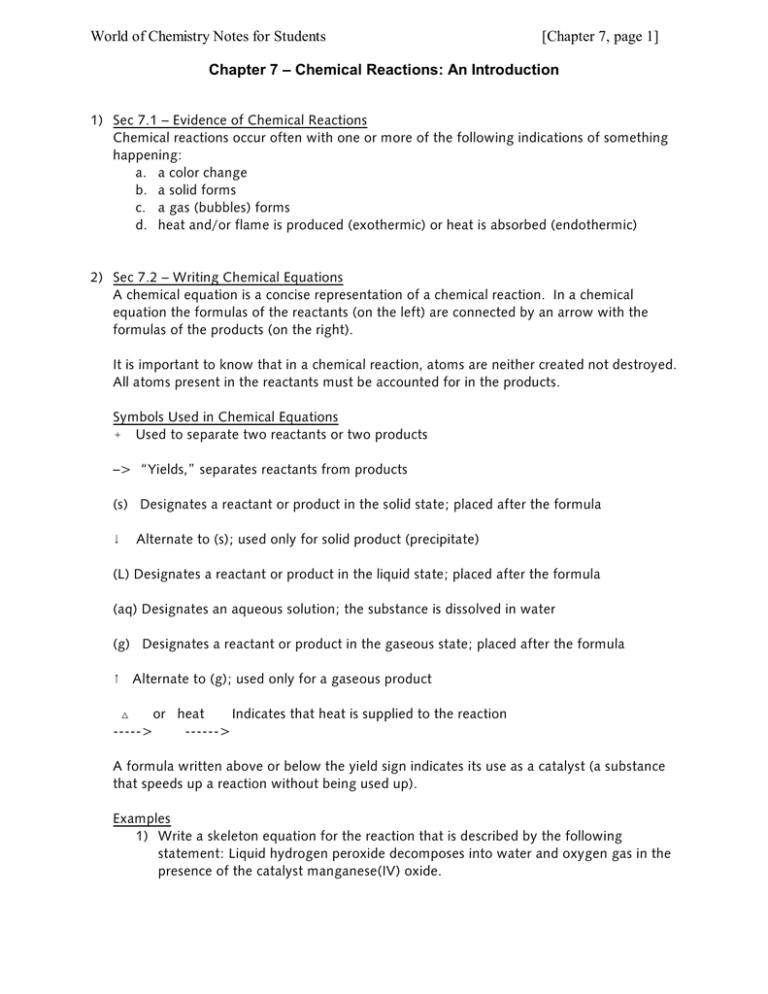Chapter 7 – Chemical Reactions: An Introduction
advertisement

World of Chemistry Notes for Students [Chapter 7, page 1] Chapter 7 – Chemical Reactions: An Introduction 1) Sec 7.1 – Evidence of Chemical Reactions Chemical reactions occur often with one or more of the following indications of something happening: a. a color change b. a solid forms c. a gas (bubbles) forms d. heat and/or flame is produced (exothermic) or heat is absorbed (endothermic) 2) Sec 7.2 – Writing Chemical Equations A chemical equation is a concise representation of a chemical reaction. In a chemical equation the formulas of the reactants (on the left) are connected by an arrow with the formulas of the products (on the right). It is important to know that in a chemical reaction, atoms are neither created not destroyed. All atoms present in the reactants must be accounted for in the products. Symbols Used in Chemical Equations % Used to separate two reactants or two products –> “Yields,” separates reactants from products (s) Designates a reactant or product in the solid state; placed after the formula 9 Alternate to (s); used only for solid product (precipitate) (L) Designates a reactant or product in the liquid state; placed after the formula (aq) Designates an aqueous solution; the substance is dissolved in water (g) Designates a reactant or product in the gaseous state; placed after the formula 8 Alternate to (g); used only for a gaseous product Î or heat Indicates that heat is supplied to the reaction -----> ------> A formula written above or below the yield sign indicates its use as a catalyst (a substance that speeds up a reaction without being used up). Examples 1) Write a skeleton equation for the reaction that is described by the following statement: Liquid hydrogen peroxide decomposes into water and oxygen gas in the presence of the catalyst manganese(IV) oxide. World of Chemistry Notes for Students [Chapter 7, page 2] 2) Write a sentence that describes the following reaction: Mg (s) + HCl (aq) -------> MgCl2 (aq) + H 2 (g) 3) Sec 7.3 – Balancing Chemical Equations In every balanced chemical equation, each side of the equation has the same number of atoms of each element. The formulas for the compounds involved in the chemical reaction must never be changed in balancing a chemical equation. Many chemical equations can be balanced by trial and error. Rules for Balancing Chemical Equations 1) Determine the correct formulas for the reactants and products in the reaction. 2) Write the formulas for the reactants on the left and the formulas for the products on the right with an arrow in between. If two or more reactants or products are involved, separate their formulas with plus signs. 3) Count the number of atoms of each element in the reactants and products. A polyatomic ion appearing unchanged on both sides of the equation is counted as a single unit. 4) Balance the elements one at a time by using coefficients. A coefficient is a small whole number that appears in front of a formula in an equation. When no coefficient is written, it is assumed to be 1. It is usually best to begin balancing by assuming that the most complex substance has a coefficient of 1. (DO NOT change the subscripts in the chemical formula of a substance.) 5) Check each atom or polyatomic ion to be sure that the equation is balanced. 6) Finally, make sure that all the coefficients are in the lowest possible ratio. Examples 1) Balance the following equations. a) Al (s) + N2 (g) ----> b) Al (s) + c) NaCl (aq) d) C 2 H 5 OH CuSO4 + (L) + O2 ----> (aq ) H2 SO4 (g) AlN (aq) -----> ----> (s) Cu (s) + Na 2 SO4 CO 2 (g) Al2 (SO4 )3 (aq) + + HCl (aq) H2 O (L) 2) Rewrite these word equations as balanced chemical equations. You do not have to indicate the physical state of the chemicals. a) sodium + water ----> sodium hydroxide + hydrogen b) iron(III) chloride + calcium hydroxide ----> iron(III) hydroxide + calcium chloride World of Chemistry Notes for Students 3) [Chapter 7, page 3] Write a balanced chemical equation for the following reaction (include symbols to represent the physical state of each substance): When solid mercury(II) sulfide is heated with oxygen gas, liquid mercury and gaseous sulfur dioxide are produced.

